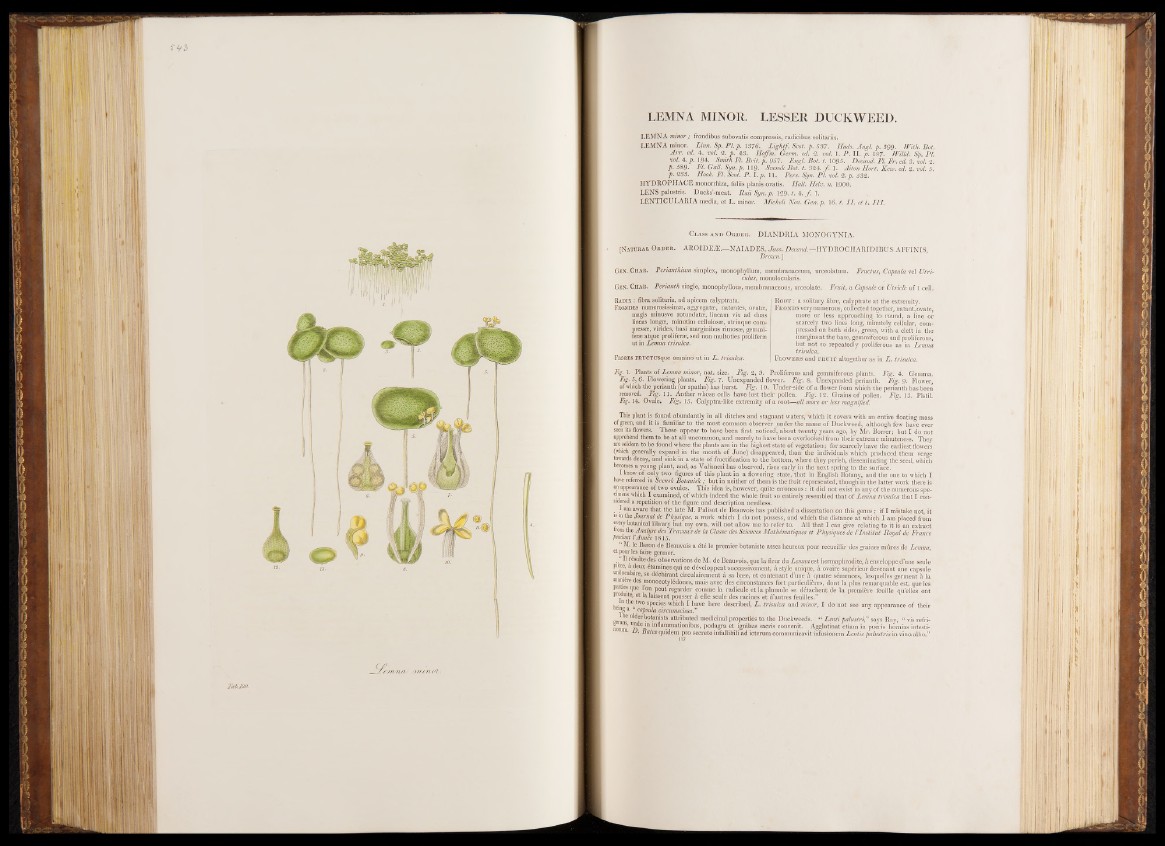
LEMNA MINOR. LESSER DUCKWEED.
LEMNA minor ; frondibus subovatis compressis, mdicibus sol i tariis.
LEMNA minor. L im .S p .P l.p . 1876. Lightf. Scot. p. 537. Huds. Angl. p . 399. With. Bot.
Arr: at. 4. ml. a. p. 43. Hoffm. Germ. ed. 2. ml. 1. P . II. p. 187. IVilld. Sp. PI.
ml. 4. p . 194. Smith FI. Brit, p , 957. Engl. Bot. t. 1035. Decand. FI. Fr. ed. 3. ml. 2.
p . 589. FI. Gall. Syn. p. 119 . Somsk Bot. t. 324. ƒ . 1. Alton Hort. Kew. ed. 2. ml. 5.
p . 233. Hook. FI. Scot. P . l .p . 1 1 . Pert. Syn. PI. ml. 2'.p. 532.
IIYDROPHACE monorrhiza, foliis planis ovatis. Hall. Helv. n. 1900.
LENS palustris. Ducks’-meal. Raii Syn. p . 129. t. 4. f . 1.
LENTICULARIA media, et L. minor. Micheli Ndo. Gen. p. 16. t. I I . et t. I I I .
C la ss AND Ord e r . DIANDRIA MONOGYNIA.
[Natural Ord e r . AROIDEÆ.—NAIADES, Jms. Decand.—HYDROCHARIDIBUS AFFINIS,
B n w i . l l , .
Gen. .Char. Perianthium simplex, monophyllum, membranaceum, urceolalum. Fructus, Capsula vel XJtri-
cuius, monolocularis.
Gen. Char. Perianth single, monophyllous, membranaceous, urceolate. Fruit, a Capsule or Utricle of 1 cell.
Radix : fibra solitaria, ad apicem calyptrata.
Frondes numerosissimæ, aggregatæ, natantes, ovatæ,
inagis minusve rotundatæ, lineam vix ad duas
lineas longæ, minutim cellulosæ, utrinque compressas,
virides, basi marginibus rimosæ, gemmi-
feræ atque proliféras, sed non multoties proliféras
ut in Lemna trisulca.
Fiores fruct usque omnino ut in L . trisulca.
Root : a solitary fibre, calyptrate at the extremity.
Fronds very numerous, collected together, natant, ovate,
more or less approaching' to round, a line or
scarcely two lines long, minutely cellular, compressed
on both sides, green, with a cleft in the
margins a t the base, gemmiferous and proliferous,
but not so repeatedly proliferous as in Lemna
trisitlca.
Flowers and fr u it altogether as in L. trisulca.
Fig. 1. Plants of Lemna minor, nat. size. Fig. 2 ,3 . Proliferous and gemmiferous plants. Fig. 4. Gemma.
Fig. 5, 6. Flowering plants. Fig. 7. Unexpanded flower. Fig. 8. Unexpended perianth. Fig. 9. Flower,
of which the perianth (or spatha) has burst. Fig. 10. Under-side o f a flower from which the perianth has been
removed. Fig. 11. Anther whose cells have lost their pollen. Fig. 12. Grains of pollen. Fig. 13. Pistil.
Fig. 14. Ovule. Fig. 15. Calyptra-lifce extremity of a root—all more or less magnified.
This plant is found abundantly in all ditches and stagnant waters, which it covers with an entire floating mass
of green, and it is familiar to the most common observer under the name of Duckweed, although few have ever
seen its flowers. These appear to have been first noticed, about twenty years ago, by Mr. Borrer; but I do not
apprehend them to be at all uncommon, and merely to have been overlooked from their extreme minuteness. They
are seldom to be found where the plants are in the highest state of vegetation; for scarcely have the earliest flowers
(which generally expand in the month of June) disappeared, than the individuals which produced them verge
towards decay, and sink in a state of fructification to the bottom, where they perish, disseminating the seed, which
becomes a young plant, and, as Yalisneri has observed, rises early in the next spring to the surface.
I know of only two figures of this plant in a flowering state, that in English Botany, and the one to which I
have referred in Svenslc Bot anisic ; but in neither of them is the fruit represented, though in the latter work there is
a.n appearance of two ovules. This idea is, however, quite erroneous : it did not exist in any of the numerous spe-
cimens which I examined, of which indeed the whole fruit so entirely resembled that o f Lemna trisulca that I considered
a repetition of the figure and description needless.
I am aware that the late M. Palisot de Beauvois has published a dissertation'on this genus; if I mistake not, it
is in the Journal de Physique, a work which I do not possess, and which the distance at which I am placed from
every botanical library but my own, will not allow me to refer to. All that I can give relating to it is an extract
irom the Analyse des Travaux de la Classe des Sciences Mathématiques et Physiques de l'Institut Royal de France
pendant VAnnée 1815.
“ M. le Baron de Beauvois a été le premier botaniste assez heureux pour recueillir des graines mûres de Lemna,
et pour les faire germer.
Il résulte des observations de M. de Beauvois, que la fleur du Lemna est hermaphrodite, à enveloppe d’une seule
pi ce, a deux étamines qui se développent-successivement, à style unique, à ovaire supérieur devenant une capsule
uniloculaire, se déchirant, tirculairement à sa base, et contenant d’une à quatre sémences, lesquelles germent à la
manière des monocotylédones, mais avec des circonstances fort particulières, dont la plus remarquable est, que les
îe? ^ue \ on Peut regarder comme la radicule et la plumule se détachent de la première feuille qu’elles ont
" I h’ e*: a ^a's®en*- pousser à elle seule des racines et d’autres feuilles.”
hni ° e, ° sPecies which I have here described, L . trisulca and minor, I do not see any appearance of their
eing a ‘ capsula circumscissa.”
16 °^®r botanists attributed medicinal properties to the Duckweeds. “ Lenti palustri," says Ray, “ vis refri-
norum n M” *n®ai? mat‘on*bus, podagra et ignibus sacris convenit. Agglutinât etiam in pueris hernias intesti-
•: D. Bates quidem pro secreto infallibili ad icterum communicavit infusionem Lentis palustris in vino albo.”